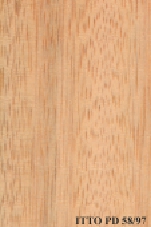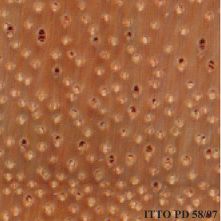
ANDOUNG (Monopetalanthus coriaceus)
Trade Name
Andoung
Scientific Name
Monopetalanthus coriaceus Mor.
Family
LEGUMINOSAE
Common Names
N'Douma (France); N'Douma (Gabon); Andung (Equatorial Guinea); Kikayi (Congo); Zoele (Cameroon); Ekop Zoélé (Cameroon); Ekop Mayo (Cameroon); Ekop (Equatorial Guinea); N`douma (Gabon); N`douma (France); Andoung (Gabon); Andjung (Equatorial Guinea)
Scientific Name Synonyms
Bikinia coriacea (Morel ex Aubrev.) Wieringa
Description Of The Tree
Botanical Description
The tree reaches a height of 32 to 40 m. The bole is generally cylindrical and quite high, with buttresses at the base. The trunk diameter attains 80 to 130 cm.
Natural Habitat
Monopetalanthus coriaceus is reported in low areas as well as on montane slopes
Natural Distribution
West Africa, particularly in countries south of the Gulf of Guinea : Gabon, Cameroon, Republic of the Congo and the Democratic Republic of the Congo.
Wood Identification
Anatomic Description Of Wood
Wood diffuse porous. Occasionally vessels exclusively solitary (over 90%). Tangential diameter of vessel lumina 150 to 200 micras (medium). Vestured pits. Vessels per mm2 6 to 10 (medium). Simple perforation plates. Vessel-ray pits similar to intervessel pits i Occasionally axial parenchyma in marginal or in seemingly marginal bands. Apotracheal axial parenchyma diffuse and/or diffuse in aggregates. Paratracheal axial parenchyma scanty and/or vasicentric. Prismatic crystals in chambered axial parenchyma cells and/o Rays more than 10 per mm (abundant). Rays and/or axial elements irregularly storied. Rays 1 to 2 seriate. Rays exclusively uniseriate. Body ray cells procumbent with one row of upright and/or square marginal cells (Kribs-III). Non-septate fibers. Fibers with simple to minutely bordered pits.
-
 Wood Macro Photo Tangential Plane
Wood Macro Photo Tangential Plane
-
 Wood Micro Photo Of Transversal Section
Wood Micro Photo Of Transversal Section
Availability
Cites Status
Unrestricted
General Wood Description
Color
The heartwood is light brown to pinkish brown ; darkens slightly on exposure, it is not clearly demarcated. The silver figure is barely visible.
COLOR INDEX (1=Black, 7=Light yellow,white)
7
Grain
Interlocked grain is high but not frequent. Special care is needed when drying because of frequent risks of distortion.
Texture
This species is reported to have a fine to medium texture.
Luster
This wood is frequently low in luster.
Natural Durability
Not durable; important risks of decay attacks at any processing step, from logs up to final products. It must receive preservative treatment. Sensible to termites attack. The heartwood is sensible to Lyctus attacks.
Natural durability index (1= Very high durability, 7=Vey low durability)
5
Internal Growth Stresses
No residual stresses are reported in this species.
Silica Content
Silica Content: Negligible content of silica is reported. Amounts over 0.05% may affect wood processing. Silica Value: 0.01
Resistance To Impregnation
Moderately easy to treat with a partial penetration of the preservative products.
Wood Physical Properties
Basic Density or Specific Gravity (O.D. weight/vol. green) (g/cm³)
0.55
Air-dry Density (Weight and volume at 12%MC) (g/cm³)
0.60
Total shrinkage Tangential (Saturated to 0%MC) (%)
7.5
Total shrinkage Radial (Saturated to 0%MC) (%)
3.8
Drying Defects
Ease of Drying: Drying is moderately difficult to difficult; special care is systematically needed. Drying Defects: Risks of resin exudation Kiln Schedules: The kiln schedule has been tested.
Recommended Dry Kiln Schedule
FR-6
Dimensional stability ratio (Total Tangential Shrinkage %/Total Radial Shrinkage %)
2.0
Wood Chemical Properties
Wood Mechanical Properties
Bending Strength (MOR),12%MC (kgf/cm²)
1024
Stiffness (MOE) 12%MC (kgf/cm²)
150660
Compression parallel to fiber 12%MC (kgf/cm²)
526
Compression perpendicular to fiber 12%MC (kgf/cm²)
66
Shear strength radial 12%MC (kgf/cm²)
73
Janka hardness (side) 12%MC (kgf)
439
Janka hardness (end grain) 12%MC (kgf)
543
Workability
Sawing
It is easy to saw.
Rotary Veneer Cutting
Suitable for peeling if treated.
Sliced Veneer
Suitable for peeling if treated.
Blunting Effect
Slight blunting effect; ordinary tools can be used for sawing and machining.
Machining
Possible difficulties caused by interlocked grain are reported.
Planing
Easy; no particular problems.
Moulding
Moderately easy; tools must be cautiously sharpened.
Boring
Moderately easy; tools must be cautiously sharpened.
Mortising
Moderately easy; tools must be cautiously sharpened.
Nailing
No particular problem.
Gluing
Glues well if basic gluing technical rules are followed.
Sanding
Difficult to obtain very good results because of interlocked grain.
Polishing
Can be polished without surface preparation.
Response To Hand Tools
No particular problems.
REFERENCED USES
End Uses Summary
HOUSING GENERAL, beams, joists, boards, flooring, parquet, frames, steps, panelling, fittings, shutter boards, FURNITURE AND CABINETS, common furniture, PLYWOOD AND VENEER, faces, cores, PACKING, heavy packing, pallets
General Housing
- 10 - Silica in Timbers
Beams
- 11 - Prospect: The wood database
Joists
- 12 - Tropical timbers of the world. Part I-Tropical American Species
Boards
- 13 - Dry kiln schedules for commercial woods. Temperate and tropical. Section III. Latin American (Mexico, Central, and South America) Woods–Conventional Temperatures
Flooring
- 14 - Handbook of Hardwoods
Parquet
- 15 - Empire Timbers
Frames
- 16 - Woods of the World
Steps
- 17 - Tree Conservation Database
Paneling
- 18 - W3TROPICOS Missouri Botanical Garden
Fittings
- 19 - Silica in Timbers
Shutter Boards
- 20 - Prospect: The wood database
Furniture Cabinets
- 21 - Tropical timbers of the world. Part III-Southeast Asian and Oceanian Species.
Furniture, Common
- 23 - Handbook of Hardwoods
Panels, Veneers
- 25 - Directory of Timber Trade Malaysia
Faces
- 26 - Annual Review and Assessment of the World Timber Situation 1998-ITTO
Cores
- 27 - Embassy of Brazil in Japan
Packing
- 45 - Recopilación y Análisis de Estudios Tecnológicos de Maderas Peruanas
Heavy Packing
- 47 - Arvores Brasileiras
Pallets
- 48 - The strength properties of timbers
Please Provide Information To View Producer Information